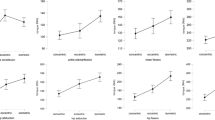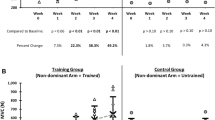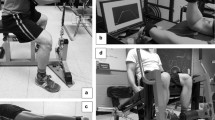Summary
A group of twenty male subjects were given 20 isometric wrist flexion trials on each limb. Two weeks later the measurement schedule was repeated on the left wrist (N = 10) and the right wrist (N = 10). Each trial was a five-second maximum exertion followed by a 30-second rest period. Compared to the first test session, the retest session two weeks later showed an improvement in absolute strength of 8.7 and 6.0 percent for right and left wrists respectively. A mean improvement in strength over all trials of 14.1 and 11.9 percent resulted for right and left wrists respectively as well.
Similar content being viewed by others
References
Duvall, E. N., S. J. Houtz, andF. A. Hellebrandt: Reliability of a single effort muscle test. Arch. phys. Med.28, 213 (1947).
Hodgkins, J.: Influence of unilateral endurance training on contralateral limb. J. appl. Physiol.16, 991 (1961).
Josenhans, W. K. T.: An evaluation of some methods of improving muscle strength. Rev. canad. Biol.21, 315 (1962).
Kroll, W.: A reliable method of assessing isometric strength. Res. Quart.34, 350 (1963).
—: Reliability variations of strength in test-retest situations. Res. Quart.34, 50 (1963).
—: Reliability of a selected measure of human strength. Res. Quart.33, 410 (1962).
McNemar, Q.: Psychological Statistics. New York: John Wiley and Sons 1962.
Muller, E. A.: Physiology of muscle training. Rev. canad. Biol.21, 303 (1962).
—, andW. Rohmert: The speed in increase of muscle strength through isometric exercises. Int. Z. angew. Physiol.19, 403 (1963).
Petersen, F. B.: Muscle training by static, concentric, and eccentric contractions. Acta physiol. scand.48, 406 (1960).
Pierson, W., andP. J. Rasch: Effect of knowledge of results on isometric strength scores. Res. Quart.35, 313 (1964).
Rose, D. L., S. F. Radzyminski, andR. R. Beatty: Effect of brief maximal exercise on the strength of the quadriceps femoris. Arch. phys. Med.38, 157 (1957).
Wright, V.: Factors influencing diurnal variation of strength of grip. Res. Quart.30, 110 (1959).
Author information
Authors and Affiliations
Additional information
This investigation was supported in part by National Institutes of Health Research Grant NB-05305-01.
Rights and permissions
About this article
Cite this article
Kroll, W. Measurement schedule effects upon isometric endurance. Int. Z. Angew. Physiol. Einschl. Arbeitsphysiol. 21, 224–229 (1965). https://doi.org/10.1007/BF00694938
Received:
Issue Date:
DOI: https://doi.org/10.1007/BF00694938




